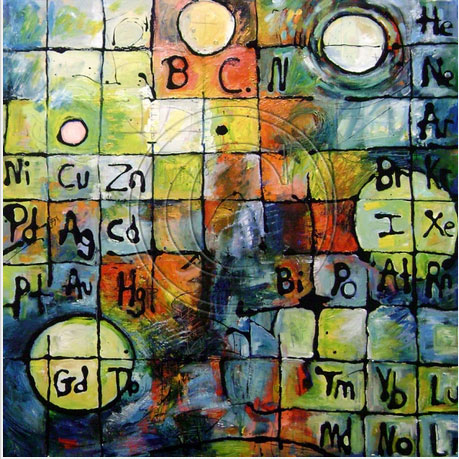 I found Princess Simpson Rashid while I was googling in Internet about the Periodic Table of chemical elements, her paintings just popped up when I asked google to see "images". My first thought was "wooo this is soberb, I have to post this". I found it so amazing that, for the first time in "Mentes Irrequietas/ Restless Minds Boosters" blog history, I felt I should write the artist before I post it, and so I did it, Princess Simpson Rashid answered me next day giving Restless Minds permission to post her work, thats why for the first time- of many more, I hope- the image has the "used with permission" statement.
I found Princess Simpson Rashid while I was googling in Internet about the Periodic Table of chemical elements, her paintings just popped up when I asked google to see "images". My first thought was "wooo this is soberb, I have to post this". I found it so amazing that, for the first time in "Mentes Irrequietas/ Restless Minds Boosters" blog history, I felt I should write the artist before I post it, and so I did it, Princess Simpson Rashid answered me next day giving Restless Minds permission to post her work, thats why for the first time- of many more, I hope- the image has the "used with permission" statement.Princess Simpson Rashid is a passionate with science. She is a Bachelor in Physics- Georgia State University-, and she studied printmaking and painting at the Escuela de Artes Plastica in San Juan, Puerto Rico.
Science-Inspired Abstraction, Modern Sport-Fencing, and Expresssionistic Landscapes are the main themes she turns to in her work. Today we are going to see only a small part of her work, the Science-Inspired Abstraction.
If you like the images you are going to see next, I strongly advise you to check Rashid website, her work is "super restless" and full of color and good energy.
At this moment Rashid lives in Tampa, Florida, USA, and in her own words:
"My current body of work explores the relationship between abstract art and math, color and music, composition and perception. I use line and color to convey movement. My painting technique often involves dripping and pouring paint until I’m satisfied with the composition. My artistic goal is to capture the individual energy and essence of the subject matter by whatever means available to me. Color, texture, design and energy are the components that make up all of my work.." in http://www.foglefineart.com/artists/profile/rashid-princess/
In this paintings Princess Simpson Rashid is a true art scientist, or "sciencartist" if you want, she uses the elements of Periodic Table, the x's and y's from math and even Pi constant from geometry (the famous 3,14). Super Restless uh?
 |
©Princess Simpson Rashid, "Periodic Table-2", Acrylic on Canvas, 36 x 60 inches. www.princessrashid.com, Used with permission. |
 |
©Princess Simpson Rashid, "Periodic Circles 2", Acrylic on Canvas, 36 x 36 inches. www.princessrashid.com, Used with permission. |
 |
©Princess Simpson Rashid, "Composition B", Acrylic on Canvas,48 x 24 inches. www.princessrashid.com, Used with permission. |
 |
©Princess Simpson Rashid, "Composition A", Acrylic on Canvas,48 x 24 inches. www.princessrashid.com, Used with permission. |
 |
©Princess Simpson Rashid, "Periodic Circles 1", Acrylic on Canvas, 36 x 36 inches. www.princessrashid.com, Used with permission. |
 |
©Princess Simpson Rashid, "Pi-1", Acrylic on Panel, 24 x 24 inches. www.princessrashid.com, Used with permission. |
Sources:
http://www.foglefineart.com
http://princessrashid.com
Et voilá!
Science and art holding hands!
Enjoy!








